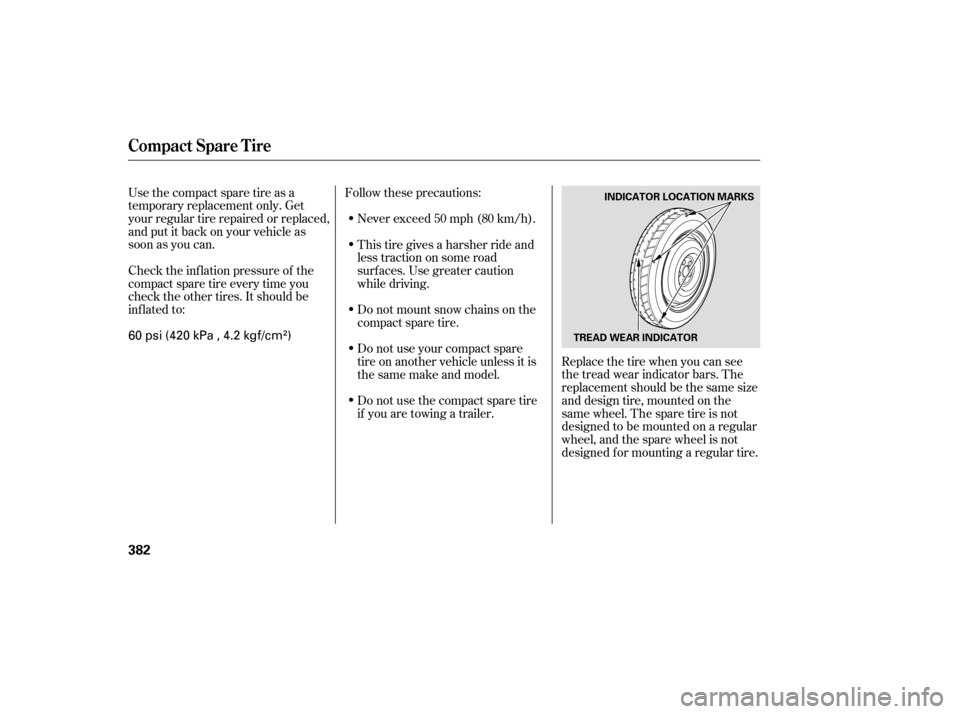Page 327 of 442

If you must stop when f acing uphill,
use the f oot brake or parking brake.
Do not try to hold the vehicle in
placebypressingontheaccelerator,
as this can cause the automatic
transmission to overheat.Crosswinds and air turbulence
caused by passing trucks can disrupt
your steering and cause the trailer to
sway. When being passed by a large
vehicle, keep a constant speed, and
steer straight ahead. Do not try to
make quick steering or braking
corrections.
Always drive slowly and have
someone guide you when backing up.
Grip the of the steering
wheel; then turn the wheel to the lef t
to get the trailer to move to the lef t,
andturnthewheelrighttomovethe
trailer to the right.Follow all normal precautions when
parking, including putting the
transmission in Park and f irmly
setting the parking brake. Also, place
wheel chocks at each of the trailer’s
tires.
bottom
Handling Crosswinds and Buf f et ing
Backing Up Parking
Towing a Trailer
Driving
323
�����—�����—�
���y�
���������
���y���
�(�)� �������y���������y
Page 347 of 442

�Î
�Î
�Ì �Ì
�Ì
�Î
Maintenance Minder
343
: Maintenance
Main Items
Replace engine oil
Replace engine oil and oil filter
Inspect front and rear brakes
Check parking brake adjustment
Inspect these items:
Tie rod ends, steering gear box, and boots
Suspension components
Driveshaft boots
Brake hoses and lines (including ABS)
All fluid levels and condition of fluids
Exhaust system
Fuel lines and connect ions Maintenance
Sub Items
Rotate tires
Replace air cleaner element
If you drive in dusty conditions, replace
every 15,000 miles (24,000 km).
Replace dust and pollen filter
If you drive primarily in urban areas that have high
concentrations of soot in the air from industry and
from diesel-powered vehicles, replace every 15,000
miles (24,000 km).
Inspect drive belt
Replace transmission and transfer fluid
Driving in mountainous areas at very low vehicle
speeds or trailer towing results in higher
transmission and transfer temperatures. This
requires transmission and transfer fluid changes
more frequently than recommended by the
maintenance minder. If you regularly drive your
vehicle under these conditions, have the transmission
and transfer fluid changed at 60,000 miles
(100,000 km), then every 30,000 miles (48,000 km).
Replace spark plugs
Inspect valve clearance
Replace engine coolant
Replace rear differential fluid
Driving in mountainous areas at very low vehicle
speeds or trailer towing results in higher level of
mechanical (shear) stress to fluid. This requires
differential fluid changes more frequently than
recommended by the Maintenance Minder. If you
regularly drive your vehicle under these conditions,
have the differential fluid changed at 7,500 miles
(12,000 km), then every 15,000 miles (24,000 km).
A
B
Symbol
Symbol
1
2
3
4
5
6
1
1
If the message ‘‘SERVICE’’ does not appear more than 12 months after the
display is reset, change the engine oil every year.
If the message ‘‘SERVICE DUE NOW’’ does not appear more than 12 months
after the display is reset, change the engine oil every year.
See information on maintenance and emissions warranty on page .
Adjust the valves during services A, B, 1, 2, or 3 only if they are noisy. Inspect idle speed every 160,000 miles (256,000 km). Independent of the maintenance items in the information display, replace
the brake fluid every 3 years.
NOTE: 1:
342
On RDX model
On RDX with Technology Package model
Maintenance Minder
�����—�����—�
���y�
�������������y���
�(�)� �������y���������y
Page 372 of 442
To replace a f ront wiper blade:Disconnect the blade assembly
from the wiper arm: Press and hold the lock tab.
Slide the blade assembly toward
the lock tab until it releases
from the wiper arm.
When replacing a wiper blade,
make sure not to drop the wiper
blade or wiper arm down on the
windshield.
Raise each wiper arm of f the
windshield, lif ting the driver’s side
first, then the passenger’s side.
Check the condition of the wiper
blades at least every six months.
Look f or signs of cracking in the
rubber, or areas that are getting
hard. Replace the blades if you f ind
these signs, or if they leave streaks
and unwiped areas when used.
2.
1.
Wiper Blades
368
WIPER ARMS
Do not open the hood when the wiper
arms are raised, or you will damage the
hood and the wiper arms.
�����—�����—�
���y�
�������������y���
�(�)� �������y���������y
Page 382 of 442

�µ
Check
the condition of the battery
monthlybylookingatthetest
indicator window. The label on the
battery explains the test indicato r’s
colors.
If you need to connect the battery to
a charger, disconnect both cables to
prevent damaging your vehic le’s
electrical system. Always disconnect
the negative ( ) cable first, and
reconnect it last.Battery
posts,
terminals, and related accessories
contain lead and lead compounds.
If
additional battery maintenance is
needed, see your dealer or a
qualified technician.
Check
the terminals for corrosion (a
white or yellowish powder). To
remove it, cover the terminals with a
solution of baking soda and water. It
will bubble up and turn brown. When
this stops, wash it off with plain
water. Dry off the battery with a
cloth or paper towel. Coat the
terminals with grease to help prevent
future corrosion.
If your vehicle’s battery is
disconnected, or goes dead, the time
setting will be reset to 1:00. To set
the time again, f ollow the setting
procedure (see page ). 198
On RDX modelsWARNING:
Wash your hands af ter handling.
Checking the Battery
378
TEST INDICATOR WINDOW
The battery gives off explosive
hydrogen gas during normal
operation.
A spark or flame can cause the
battery to explode with enough
force to kill or seriously hurt you.
Wear protective clothing and a
face shield, or have a skilled
technician do the battery
maintenance.
�����—�����—�
���y�
���������
���y���
�(�)� �������y���������y
Page 384 of 442

Fill the f uel tank.
Change the engine oil and f ilter.
Wash and dry the exterior
completely.
Cleantheinterior.Makesurethe
carpeting, floor mats, etc., are
completely dry.Block the rear wheels.
If the vehicle is to be stored f or a
longer period, it should be
supported on jackstands so the
tires are of f the ground.
Cover the vehicle with a
‘‘breathable’’ cover, one made
f rom a porous material such as
cotton. Non-porous materials, such
as plastic sheeting, trap moisture,
which can damage the paint.
If you need to park your vehicle f or
an extended period (more than 1
month), there are several things you
should do to prepare it f or storage.
Proper preparation helps prevent
deterioration and makes it easier to
get your vehicle back on the road. If
possible, store your vehicle indoors. Leave one window open slightly (if
the vehicle is being stored
indoors).
Disconnect the battery.
Support the f ront and rear wiper
blade arms with a f olded towel or
ragsotheydonottouchthe
windshield.
To minimize sticking, apply a
silicone spray lubricant to all door
and tailgate seals. Also, apply a
vehiclebodywaxtothepainted
surfaces that mate with the door
and tailgate seals.If possible, periodically run the
engine until it reaches f ull
operating temperature (the
cooling f ans cycle on and of f
twice). Pref erably, do this once a
month.
Leave the parking brake off. Put
the transmission in Park.
Vehicle Storage
380
�����—�����—�
���y�
�������������y���
�(�)� �������y���������y
Page 385 of 442

This section covers the more
common problems that motorists
experience with their vehicles. It
gives you inf ormation about how to
safely evaluate the problem and what
to do to correct it. If the problem has
stranded you on the side of the road,
you may be able to get going again.
If not, you will also f ind instructions
on getting your vehicle towed.......................
Compact Spare Tire .382
....................
Changing a Flat Tire .383
.............
If the Engine Won’t Start .387
................................
Jump Starting .389
..............
If the Engine Overheats .391
.........
Low Oil Pressure Indicator .393
..........
Charging System Indicator .393
.......
Malf unction Indicator Lamp .394
....
Brake System Indicator (Red) .395
Brake System Indicator
.....................................
(Amber) .396
..............................................
Fuses .397
..............................
Fuse Locations .401
......................
Emergency Towing .403
Taking Care of the Unexpected
T aking Care of t he Unexpect ed
381
�����—�����—�
���y�
�������������y���
�(�)� �������y���������y
Page 386 of 442

Use the compact spare tire as a
temporary replacement only. Get
your regular tire repaired or replaced,
and put it back on your vehicle as
soon as you can.
Check the inf lation pressure of the
compact spare tire every time you
check the other tires. It should be
inf lated to:Replace the tire when you can see
the tread wear indicator bars. The
replacement should be the same size
and design tire, mounted on the
same wheel. The spare tire is not
designed to be mounted on a regular
wheel, and the spare wheel is not
designed f or mounting a regular tire.
Follow these precautions:
Never exceed 50 mph (80 km/h).
This tire gives a harsher ride and
less traction on some road
surf aces. Use greater caution
while driving.
Do not mount snow chains on the
compact spare tire.
Do not use your compact spare
tire on another vehicle unless it is
thesamemakeandmodel.
Do not use the compact spare tire
if you are towing a trailer.
Compact Spare Tire
382
INDICATOR LOCATION MARKS
TREAD WEAR INDICATOR
60 psi (420 kPa , 4.2 kgf/cm)
�����—�����—�
���y�
�������������y���
�(�)� �������y���������y
Page 387 of 442

If you have a f lat tire while driving,
stop in a saf e place to change it.
Drive slowly along the shoulder until
you get to an exit or an area that is
far away from the traffic lanes.Park the vehicle on f irm, level, and
non-slippery ground. Put the
transmission in Park. Apply the
parking brake.
If you are towing a trailer, unhitch
it.
Open the tailgate. Raise the cargo
area f loor lid by lif ting it up with
the strap, then remove the lid.
The spare tire, jack, and tools are
under the cargo area f loor.
Turn on the hazard warning lights,
and turn the ignition switch to the
LOCK (0) position. Have all
passengers get out of the vehicle
while you change the tire.
Unscrew the wing bolt. Use the
hooked end of the wheel nut
wrench extension as a wrench if
the wing bolt is hard to loosen.
Then take the spare tire out of the
cargo area.
1.
2.
3.
4.
CONT INUED
Changing a Flat Tire
T aking Care of t he Unexpect ed
383
JACK
WING BOLT
LID
SPARE TIRE
The vehicle can easily roll off
the jack, seriously injuring
anyone underneath.
Follow the directions for
changing a tire exactly, and
never get under the vehicle
when it is supported only by the
jack.
�����—�����—�
���y�
�������������y���
�(�)� �������y���������y